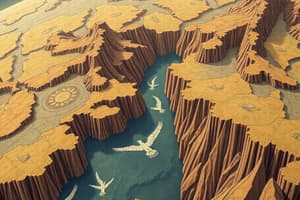Podcast
Questions and Answers
What are the two ways to describe the location of a place on the globe?
What are the two ways to describe the location of a place on the globe?
By determining its latitude and longitude, and by identifying the landmasses and bodies of water in the surrounding area.
What generates the shaking felt during an earthquake?
What generates the shaking felt during an earthquake?
The sudden release of energy in the Earth's lithosphere.
Which of the following best describes faults?
Which of the following best describes faults?
- Underground lakes.
- Thin zones of crushed blocks of rocks. (correct)
- Areas of flat land with no geological activity.
- Large mountains formed by tectonic plates.
What type of fault involves rocks sliding past one another on a horizontal plane?
What type of fault involves rocks sliding past one another on a horizontal plane?
Normal faults result from two blocks of crust pulling apart.
Normal faults result from two blocks of crust pulling apart.
Which fault is known for having one block of crust sliding on top of another?
Which fault is known for having one block of crust sliding on top of another?
What is the Ring of Fire?
What is the Ring of Fire?
Flashcards are hidden until you start studying
Study Notes
How Earthquakes Occur
- Earthquakes are caused by the sudden release of energy in the Earth's lithosphere.
- This energy is stored due to the stress built up by the movement of tectonic plates.
- The fault is a crack in the earth's crust where rocks on either side have slid past each other.
- Enough pressure develops and the rocks slip suddenly, releasing energy in waves, which causes the shaking we feel during an earthquake.
- Earth's outer layer is often pushed together, causing the rocks to grind against each other.
- The force of friction prevents the rocks from slipping immediately, leading to a buildup of pressure.
Faults
- Faults are thin zones of crushed rock blocks.
- Faults can be centimeters to thousands of kilometers long.
- Fault surfaces can be vertical or horizontal and can extend deep into the Earth.
Types of Faults
- Strike-slip faults: Rocks slide past each other horizontally with little to no vertical movement. Examples include the San Andreas Fault and the Anatolian Fault.
- Normal faults: Two blocks of crust pull apart, extending the crust into a valley, creating space. The upper side (hanging wall) moves downward with respect to the lower side (footwall).
- Reverse faults: Also known as thrust faults, one block of crust slides on top of another. These faults are found in collision zones where tectonic plates push up mountains, such as the Himalayas and Rocky Mountains.
1906 San Francisco Earthquake
- The San Francisco earthquake was caused by a fast movement along a strike-slip fault.
- The movement caused an offset, which is the amount of displacement along the fault.
Ring of Fire
- This is an area surrounding the Pacific Ocean characterized by trenches and subduction zones.
- Subduction zones occur where one tectonic plate slides beneath another.
- The presence of subduction zones contributes to the high frequency of earthquakes in the Ring of Fire.
Studying That Suits You
Use AI to generate personalized quizzes and flashcards to suit your learning preferences.




